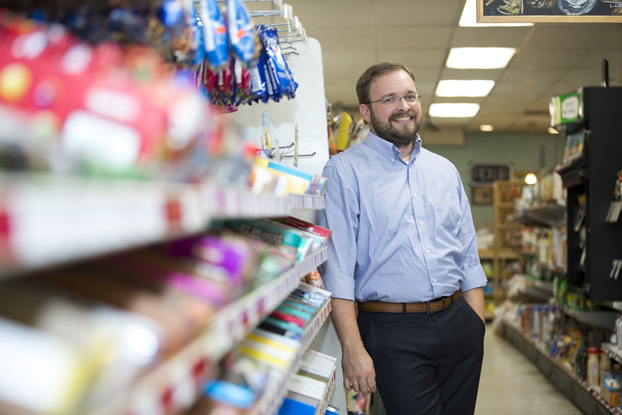Retailers and marketing researchers have long pondered consumer psychology to get a better understanding of just what motivates a shopper to select one item over another. “Sometimes the results are obvious, but at other times it can be quite vexing to grasp what moves consumers to reach for their wallets,” says Ryan Hamilton, associate professor of marketing and Caldwell research fellow. Hamilton concentrates his research efforts on the intersection of product pricing and branding, but it is the counterintuitive choices that consumers sometimes make that truly fascinate him and propel his work forward.
It’s an area ripe for investigation. Shopper decision-making is a complicated process, involving brand, price, and “choice architecture.” Choice architecture is, simply put, the way retailers decide to present products to shoppers, whether it’s the number of items available or the attributes they decide to feature. Hamilton’s current research is helping companies uncover the impact that retailer price image has on a shopper’s preferences. Hamilton argues that retailers need to know how to set and maintain a reputation for price, since it helps to tap into a particular consumer audience. For instance, a big box store needs to focus on being known for cut-rate prices, while an upscale retailer should create an air of exclusivity by setting and keeping prices high. It’s really all about making sure brand and pricing sync up to develop shopper loyalty.
It sounds like a simple thing to do—set a price and be known for it. However, Hamilton acknowledges it’s a much more difficult process than most retailers understand. “It’s possible to have objectively lower prices and consumers still might believe the opposite,” he says. Hamilton cites Target and Walmart as perfect examples. “Target has often met or beat Walmart on pricing, but Walmart maintains an ironclad price image as cheaper than the competition. They’re winning the war of public opinion even in the face of empirical evidence.” And, price reputation can drive a consumer to select one retailer over another.
Hamilton acknowledges there are quite a few misconceptions when it comes to price and branding and their impact on shopping habits. “A lot of retailers assume managing price image is simply managing pricing,” he says. But it’s a big error to silo off a retailer’s marketing people from the people who do pricing in the company. “Impressions can be everything,” he says. Retailers have to ask themselves what messages they are sending out through the look of their advertising, the appearance of their stores, or the level of customer service.
As it turns out, consumer psychology is everything. It can certainly impact how much a shopper decides to spend on a new product. In a new research paper, Hamilton delves into how shoppers decide to set price limits on the things they buy. The results of his research, he says, were quite surprising. When people set a hard limit for an item, maybe $300 for a television, they generally end up spending more. “What we’ve found is that when you make a choice, generally speaking, you make a tradeoff between price and quality.” The restraint on the price actually forces consumers to consider a higher priced item, which they see as better quality.
Hamilton notes that his research has rich implications for business. “It’s a nice thing when you bridge the gap between business theory and practice,” he says. Even the most groundbreaking theoretical discoveries may not have an application for businesses in the short run. Hamilton adds, “I do see science and practice as occasionally bumping up against each other. Researchers will pursue work that’s interesting, and we hope that moves the science forward and the findings can be applied to customers or industry.”
Fortunately, Hamilton’s research is also finding a wider audience. In his new book released earlier this year, The Intuitive Customer: 7 Imperatives For Moving Your Customer Experience to the Next Level, Hamilton and coauthor Colin Shaw translate marketing theory into a tool kit that managers can use to help shape the customer experience. The book explores what businesses can do to boost their return on investment (ROI) by focusing on the emotional, subconscious, and psychological experience of shopping. Often, Hamilton says, habits move a customer’s decision about what to buy. Customer loyalty is also a function of memory. In the book, Hamilton and Shaw argue that retailers need to be aware of how to manage shoppers’ memories of their store experiences.
Hamilton’s enthusiasm for the field of consumer behavior is translating well to his research at Goizueta and his teaching, too. “I’ve been able to flourish here from a research perspective, and that’s not always true at other schools.” His students are also helping him to push his research into new directions. “I engage with business students who push me back from the brink of diving too deeply into the theory alone, and it encourages me to think in different ways,” Hamilton says.
The research and review process can be long and arduous for an academic, so a professor’s path has to be one that is rich for study. Consumer psychology provides a vast area of investigation, even if it can be mystifying at times. “As an academic and researcher, you need to have a passion,” Hamilton argues. “Mine is really about the foibles of consumer decision-making.” At the end of the day, it is this passion for the unknown that keeps Hamilton coming back to plumb the depths of consumer behavior.











